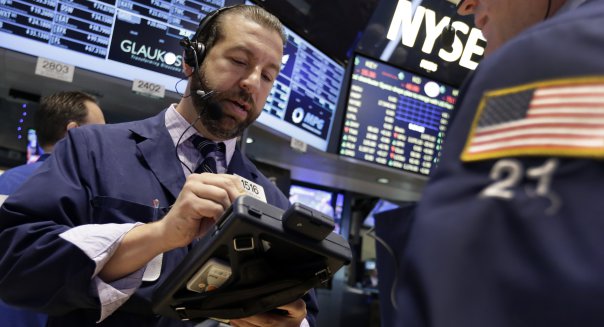
NEW YORK — U.S. stocks fell sharply Monday in heavy trading, and the S&P 500 and the Dow had their worst day since October after a collapse in Greek bailout talks intensified fears that the country could be the first to exit the eurozone.
The European Central Bank froze funding to Greek banks, forcing Athens to shut banks for a week to keep them from collapsing.
And Greece appeared to confirm it was heading for a default after a government official said the country wouldn’t pay a 1.6 billon euro loan installment due Tuesday to the International Monetary Fund.
U.S. investors also worried about Puerto Rico’s debt problems and a bear market in China the day before quarter-end and ahead of Thursday’s U.S. jobs report and the long weekend for U.S. Independence Day.
“None of that bodes well for people stepping in and buying the dips as has been the mentality most of the year,” Michael James, managing director of equity trading at Wedbush Securities in Los Angeles who said U.S. shares could fall again Tuesday.
“Could that reverse itself tomorrow? It’s going to take a lot of good news from Greece,” he said noting that portfolio managers wouldn’t want to show risky equities on their books at the end of the second quarter.
The Standard & Poor’s 500 index (^GSPC) and Dow Jones industrial average (^DJI) had their worst days since Oct. 9 and both turned slightly negative for the year to date. The last annual decline for both indexes was 2008. The Nasdaq had its biggest one-day percentage decline Monday since March 25.
Volatility rose sharply and all 10 S&P sectors retreated while the Global X FTSE Greece exchange-traded fund, which tracks the Athens stock market, fell 20 percent. In Europe, the blue-chip Euro Stoxx 50 index had suffered its biggest one-day fall since 2011.
There is no mechanism to be ejected from the European Union. This has never happened before.
“There is no mechanism to be ejected from the European Union. This has never happened before,” said Brian Battle, director of trading at Performance Trust Capital Partners in Chicago. “When you don’t know what could happen you sell. You get on the sidelines.”
While the Greek economy is small and most U.S. corporations have limited direct exposure, investors are concerned about the fallout across Europe if Greece exits the eurozone.
A snap Reuters poll of economists and traders found a median 45 percent probability that Greece would leave the eurozone.
Chinese stocks had closed sharply lower after a volatile day of trading despite surprise monetary easing by the central bank.
On top of this, U.S. territory Puerto Rico faces a restructuring of its $73 billion debt burden.
The Dow Jones industrial average fell 350.33 points, or 1.95 percent, to 17,596.35, the S&P 500 lost 43.85 points, or 2.09 percent, to 2,057.64 and the Nasdaq composite (^IXIC) dropped 122.04 points, or 2.4 percent, to 4,958.47.
The CBOE Volatility index, a measure of the premium traders are willing to pay for protection against a drop in the S&P 500, jumped 34.5 percent to 18.86, its highest level in almost five months
S&P 500 Index (Closing) – 1 Year | FindTheData
Financials was the worst S&P sector with a 2.44 percent decline. U.S. banks have an exposure to $12.7 billion of Greek debt.
JPMorgan Chase (JPM), down 2.5 percent, was the biggest drag on the S&P financial sector followed by Wells Fargo (WFC), down 2.4 percent. Goldman Sachs (GS) weighed the most on the Dow with a 2.6 percent decline.
Assured Guaranty (AGO) fell 13.3 percent and MBIA (MBI) fell more than 23.4 percent after BTIG downgraded the insurers on concerns over Puerto Rico’s debts.
Declining issues outnumbered advancing ones on the NYSE by 2,874 to 282, for a 10.19-to-1 ratio on the downside; on the Nasdaq, 2,469 issues fell and 367 advanced for a 6.73-to-1 ratio favoring decliners.
The benchmark S&P 500 index was posting 2 new 52-week highs and 25 new lows; the Nasdaq composite was recording 48 new highs and 126 new lows.
About 7.3 billion shares changed hands on U.S. exchanges, compared with the 6.3 billion average for the month-to-date, according to data from BATS Global Markets.
-.
What to watch Tuesday:
ConAgra Foods (CAG) reports quarterly financial results before U.S. stock markets open.
Standard and Poor’s releases the S&P Case-Shiller home price index for April at 9 a.m. Eastern time.
The Institute For Supply Management-Chicago releases its survey of purchasing managers for June at 9:45 a.m.
The Conference Board releases its Consumer Confidence survey at 10 a.m.
•Wall Street Rallies on Fed Rate Hike
•Fed Raises Interest Rates, Cites Ongoing US Economic Recovery
•US Aerospace Sector Poised for 2015 Record Trade Surplus: Group


Leave a Reply